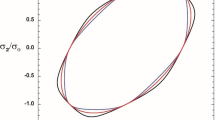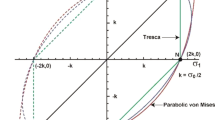Abstract
By appending a constant to the Weierstrass form of the conventional Tresca yield condition, a new yield condition is generated that allows a continuous transition of yield criteria spanning the Tresca to the von Mises and beyond. The Weierstrass form of the Tresca yield condition is defined by a cubic algebraic relationship between the second and third invariants of the deviatoric stress tensor. In general, the Weierstrass form is commonly associated with a family of plane curves called elliptic, which have special group properties. The additional parameter of the generalized Tresca yield condition is determined from an analytical expression that relates the yield strength of a material in tension to the yield strength of a material in pure shear. Solutions of plane stress, perfectly plastic, mode I crack problems are then obtained for the generalized Tresca yield condition for variations in this parameter. Through insight gained by varying this parameter, an analytical mode I perfectly plastic solution is proposed for the traditional Tresca yield condition under plane stress loading conditions. Unlike the corresponding mode I perfectly plastic solution for the von Mises yield condition, which has three distinct sectors in the upper half plane of symmetry, the solution for the Tresca yield condition requires a fourth distinct sector.














Similar content being viewed by others
References
Ambramowitz, M., Stegun, I.A.: Handbook of Mathematical Functions with Formulas, Graphs, and Mathematical Tables, National Bureau of Standards, Applied Mathematics Series 55. US Government Printing Office, Washington, DC (1964)
Unger, D.J.: Yield criteria representable by elliptic curves and Weierstrass form. Procedia Struct. Integ. 35, 2–9 (2022). https://doi.org/10.1016/j.prostr.2021.12.041
Drucker, D.C.: Relationship of experiments to mathematical theories of plasticity. J. Appl. Mech. 16, 349–357 (1949). https://doi.org/10.1115/1.4010009
Hutchinson, J.W.: Plane stress and strain fields at a crack tip. J. Mech. Phys. Solids 16, 337–347 (1968). https://doi.org/10.1016/0022-5096(68)90021-5
Kendig, K.: A Guide to Plane Algebraic Curves, Dolciani Mathematical Expositions 46 / MAA Guides 7. Mathematical Association of America, Washington, DC (2011)
Mendelson, A.: Plasticity: Theory and Applications, pp. 80–87. Macmillan, New York (1968)
Unger, D.J.: Analytical Fracture Mechanics. Academic Press, San Diego (1995), Reprinted Dover, Mineola (2001), (2010)
Chakrabarty, J.: Theory of Plasticity. McGraw-Hill, New York (1987)
Hosford, W.F.: A generalized isotropic yield criterion. J. Appl. Mech. 32, 607–609 (1972). https://doi.org/10.1115/1.3422732
Karafillis, A.P., Boyce, M.C.: A general anisotropic yield criterion using bounds and a transformation weighting tensor. J. Mech. Phys. Solids 41, 1859–1886 (1993). https://doi.org/10.1016/0022-5096(93)90073-O
Carney, K., Du Bois, P., Sengoz, K., Wang, L., Kan, C.-D.: Development of a Generalized Yield Surface for Isotropic, Pressure-Insensitive Metal Plasticity with Differing Tension, Compression, and Shear Yield Strengths, DOT/FAA/TC-19/42. US NTIS, Springfield, VA (2020)
Kachanov, L.M.: Fundamentals of the Theory of Plasticity. Dover, Mineola (2004)
Ghomi, M.: Class notes (online), Lecture 5, Corollary 16, p. 6, Math 4441 Differential Geometry, Georgia Institute of Technology, Atlanta (2007). https://people.math.gatech.edu/~ghomi/LectureNotes/LectureNotes5U.pdf
Unger, D.J.: A plane stress perfectly plastic mode I crack problem for a yield condition based on the second and third invariants of the deviatoric stress tensor. J. Mech. Mater. Struct. 3, 795–807 (2008). https://doi.org/10.2140/jomms.2008.3.795
Unger, D.J.: A plane stress perfectly plastic mode I crack problem for a yield condition based on the second and third invariants of the deviatoric stress tensor. II. J. Mech. Mater. Struct. 4, 1651–1656 (2009). https://doi.org/10.2140/jomms.2009.4.1651
Timoshenko, S.P., Goodier, J.N.: Theory of Elasticity, 3\(^{rd}\) edition. McGraw-Hill, New York (1970)
Unger, D.J.: A plane stress perfectly plastic mode I crack solution with continuous stress field. J. Appl. Mech. 72, 62–67 (2005). https://doi.org/10.1115/1.1828061
Ince, E.L.: Ordinary Differential Equations, pp. 39–40. Dover, Mineola (1956)
Davis, H.T.: Introduction to Nonlinear Differential and Integral Equations, pp. 49–51. Dover, Mineola (1962)
Zwillinger, D.: Handbook of Differential Equations. Academic Press, Boston (1989)
Weisstein. E.W.: CRC Concise Encyclopedia of Mathematics, 2nd ed. Chapman & Hall/CRC, Boca Raton (2002)
Hershey, A.V.: The plasticity of an isotropic aggregate of anisotropic face centered cubic crystals. J. Appl. Mech. 21, 241–249 (1954). https://doi.org/10.1115/1.4010900
Hellan, K.: Introduction to Fracture Mechanics, pp. 166–169. McGraw-Hill, New York (1984)
Unger, D.J.: Perfectly plastic caustics for the opening mode of fracture. Theoret. Appl. Fract. Mech. 44, 82–94 (2005). https://doi.org/10.1016/j.tafmec.2005.05.007
Broberg, K.B: Cracks and Fracture, pp. 308–327. Academic Press, San Diego (1999)
Author information
Authors and Affiliations
Corresponding author
Additional information
Publisher's Note
Springer Nature remains neutral with regard to jurisdictional claims in published maps and institutional affiliations.
Rights and permissions
About this article
Cite this article
Unger, D.J. Generalized Tresca yield condition as a family of elliptic curves with application to mode I crack problems. Z. Angew. Math. Phys. 73, 184 (2022). https://doi.org/10.1007/s00033-022-01825-6
Received:
Revised:
Accepted:
Published:
DOI: https://doi.org/10.1007/s00033-022-01825-6
Keywords
- Transition model
- Tresca yield condition
- von Mises yield condition
- Perfectly plastic
- Plane stress
- Mode I crack problems
- Weierstrass form
- Elliptic curves




